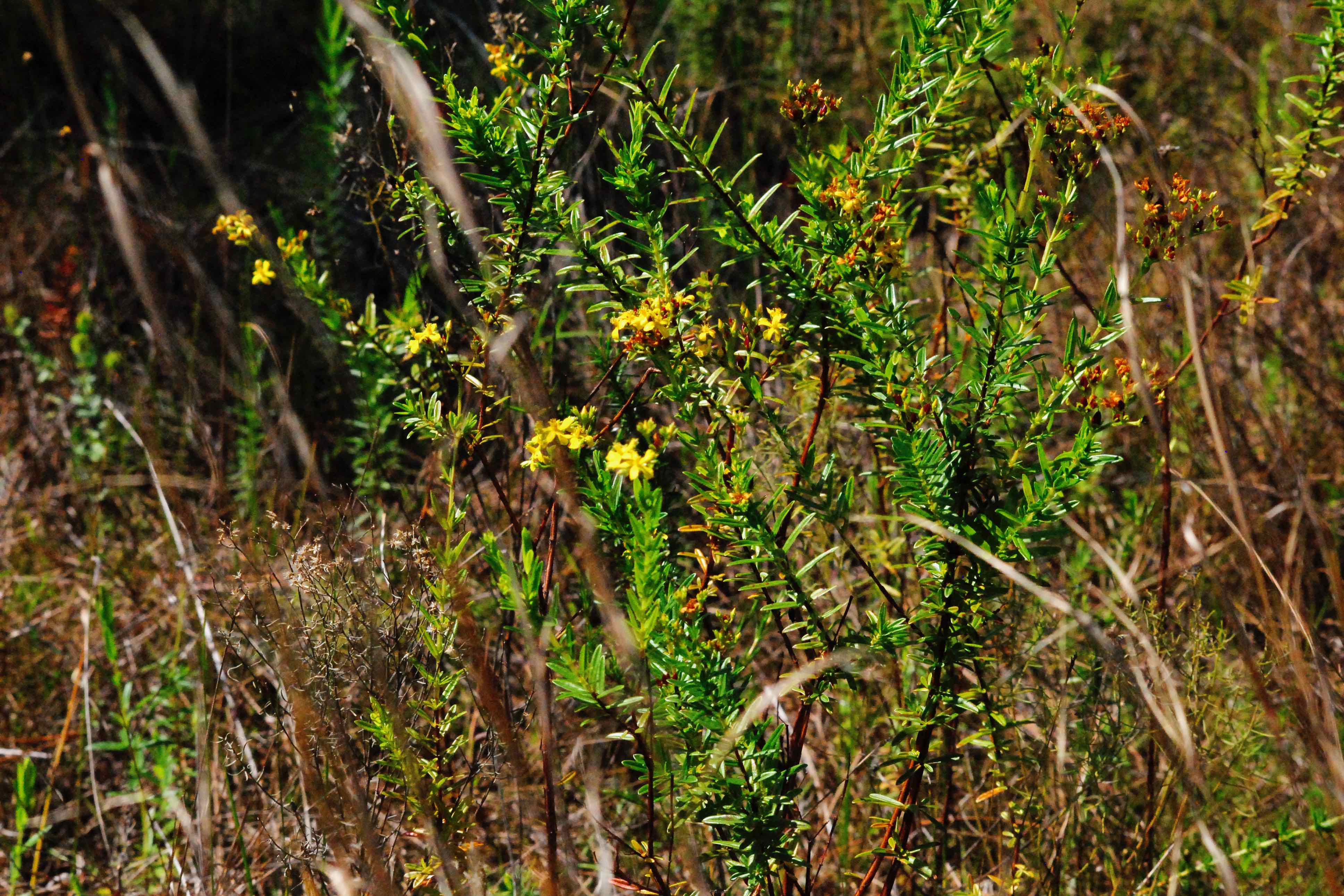
Roundpod St. John's Wort, photographed at Jonathan Dickinson State Park, Hobe Sound, Martin County, in May 2014.
The medicinal value of St. John's wort has been known since Hippocrates' time. It's been used to treat heart palpatations, cuts and bruises and inflammation. Scientists say it has some value in treating mild to moderate depression.
But not this St. John's wort — roundpod St. John's wort, Hypericum cistifolium. Looking at its bright, yellow flowers might cure you of the blues, but that's about it.
Roundpod St. John's wort, also spelled St. Johnswort, is a Florida native found throughout the state, and a fairly common one at that. It's also native to the Southeast, from North Carolina to Texas.
It is shrubby plant that typically grows to about two to three feet tall, though some sources say it can reach 12 feet, but we can't say we've ever seen anything near that. It has a single, woody stem, many-branched and usually is taller than it is broad. It almost always is found in a wet habitat — wet flatwoods and the margins of swamps and marshes. It requires full sun.
Flowers bloom in the summer. They're bright yellow, with five petals and tend to occur in clusters near the top of the plant. It's easy to overlook this plant when they're not present but nearly impossible to miss when they are. Most other St. John's-worts don't have clustered flowers.
The leaves on roundpod are opposite each other in pairs, and at right angles from the pair above and below. They tend to roll over along the edges, another hallmark of this species. It's similar in looks to two other St. John's species, Coastalplain St. John's Wort and Atlantic St. John's Wort, but these two have leaves that are much narrower — needlelike, in fact — than roundpod.
Roundpod St. John's wort is a minor source of food for both birds and mammals.
It is cultivated and used in natural landscapes, restorations and wet gardens, but it might be difficult to find a nursery that grows it. It does require wet soil, limiting where it can be used. It is minimally drought tolerant once established.
Roundpod St. John's wort is one of about 500 members of Hypericum, the genus that is the St. John's wort clan of plants. There are 31 members found in Florida, of which 12 are found in South Florida. St. John's-worts typically have yellow flowers with five petals, and leaves with glands that look like black dots. It is common St. John's-wort, H. perforatum, that has the medicinal properties. It is not found in Florida.
The nickel version of why St. John's worts got the name: Common St. John’s wort first blooms about the time of the summer solstice, and the Greeks and Romans to mark that date, would toss the flowers into a fire as a way of showing their thanks to the gods. Coincidentally, June 24, just days after the solstice, happens to be St. John’s Day, the birthday of John the Baptist, so early Christians took to calling the flowers St. John’s wort in honor of the martyred saint. Wort, by the way, means plant. The reddish substance produced when leaves were crushed became known as St. John’s blood. With the ascension of Christianity and the decline of the Greek and Roman religion, the name stuck.
Roundpod St. John's wort and other St. John's worts are members of Hypericaceae, the St. John's wort family. Until relatively recently, scientists considered Hypericaceae to be a subfamily within Clusiaceae, the mangosteen family, but now classify Hypericaceae as a family unto itself. However, you'll still see references using Clusiaceae as the family to which St. John's-worts belong.
Wort, by the way, comes from an Old English word meaning root or plant.
Jonathan Dickinson State Park
But not this St. John's wort — roundpod St. John's wort, Hypericum cistifolium. Looking at its bright, yellow flowers might cure you of the blues, but that's about it.
Roundpod St. John's wort, also spelled St. Johnswort, is a Florida native found throughout the state, and a fairly common one at that. It's also native to the Southeast, from North Carolina to Texas.
It is shrubby plant that typically grows to about two to three feet tall, though some sources say it can reach 12 feet, but we can't say we've ever seen anything near that. It has a single, woody stem, many-branched and usually is taller than it is broad. It almost always is found in a wet habitat — wet flatwoods and the margins of swamps and marshes. It requires full sun.
Flowers bloom in the summer. They're bright yellow, with five petals and tend to occur in clusters near the top of the plant. It's easy to overlook this plant when they're not present but nearly impossible to miss when they are. Most other St. John's-worts don't have clustered flowers.
The leaves on roundpod are opposite each other in pairs, and at right angles from the pair above and below. They tend to roll over along the edges, another hallmark of this species. It's similar in looks to two other St. John's species, Coastalplain St. John's Wort and Atlantic St. John's Wort, but these two have leaves that are much narrower — needlelike, in fact — than roundpod.
Roundpod St. John's wort is a minor source of food for both birds and mammals.
It is cultivated and used in natural landscapes, restorations and wet gardens, but it might be difficult to find a nursery that grows it. It does require wet soil, limiting where it can be used. It is minimally drought tolerant once established.
Roundpod St. John's wort is one of about 500 members of Hypericum, the genus that is the St. John's wort clan of plants. There are 31 members found in Florida, of which 12 are found in South Florida. St. John's-worts typically have yellow flowers with five petals, and leaves with glands that look like black dots. It is common St. John's-wort, H. perforatum, that has the medicinal properties. It is not found in Florida.
The nickel version of why St. John's worts got the name: Common St. John’s wort first blooms about the time of the summer solstice, and the Greeks and Romans to mark that date, would toss the flowers into a fire as a way of showing their thanks to the gods. Coincidentally, June 24, just days after the solstice, happens to be St. John’s Day, the birthday of John the Baptist, so early Christians took to calling the flowers St. John’s wort in honor of the martyred saint. Wort, by the way, means plant. The reddish substance produced when leaves were crushed became known as St. John’s blood. With the ascension of Christianity and the decline of the Greek and Roman religion, the name stuck.
Roundpod St. John's wort and other St. John's worts are members of Hypericaceae, the St. John's wort family. Until relatively recently, scientists considered Hypericaceae to be a subfamily within Clusiaceae, the mangosteen family, but now classify Hypericaceae as a family unto itself. However, you'll still see references using Clusiaceae as the family to which St. John's-worts belong.
Wort, by the way, comes from an Old English word meaning root or plant.
Jonathan Dickinson State Park
Click on photo for larger image
U.S. Department of Agriculture Distribution Maps






